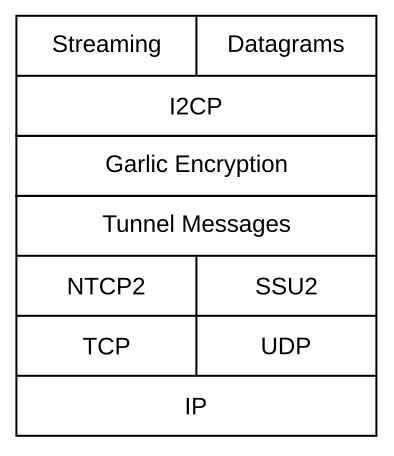Voici la pile protocole pour I2P. Voir aussi l’index de la documentation technique.
Each of the layers in the stack provides extra capabilities. The capabilities are listed below, starting at the bottom of the protocol stack.
-
Internet Layer:
IP : Protocole Internet, permet l’adréessage d’hôtes sur l’Internet ordinaire et le routage de paquets par Internet en utilisant la livraison au mieux. -
Transport Layer:
TCP: Transmission Control Protocol, allow reliable, in-order delivery of packets across the internet.
UDP: User Datagram Protocol, allow unreliable, out-of-order delivery of packets across the internet. -
I2P Transport Layer: provide encrypted connections between 2 I2P routers. These are not anonymous yet, this is strictly a hop-to-hop connection.
Two protocols are implemented to provide these capabilities. NTCP2 builds on top of TCP, while SSU uses UDP.
NTCP2: NIO-based TCP
SSU: Secure Semi-reliable UDP -
I2P Tunnel Layer: provide full encrypted tunnel connections.
Tunnel messages: tunnel messages are large messages containing encrypted I2NP (see below) messages and encrypted instructions for their delivery. The encryption is layered. The first hop will decrypt the tunnel message and read a part. Another part can still be encrypted (with another key), so it will be forwarded.
I2NP messages : les messages du protocole réseau I2P sont utilisé pour passer des messages à travers de multiples routeurs. Ces messages I2NP sont combinés dans des tunnels de messages. -
I2P couche Ail : fournit la livraison de message I2P chiffrés et anonymes de bout à bout.
I2NP messages: I2P Network Protocol messages are wrapped in each other and used to ensure encryption between two tunnels and are passed along from source to destination, keeping both anonymous.
The following layers are strictly speaking no longer part of the I2P Protocol stack, they are not part of the core 'I2P router' functionality. However, each of these layers adds additional functionality, to allow applications simple and convenient I2P usage.
-
I2P Client Layer: allow any client to use I2P functionality, without requiring the direct use of the router API.
I2CP: I2P Client Protocol, allows secure and asynchronous messaging over I2P by communicating messages over the I2CP TCP socket. -
I2P End-to-end Transport Layer: allow TCP- or UDP-like functionality on top of I2P.
Streaming Library: an implementation of TCP-like streams over I2P. This allows easier porting of existing applications to I2P.
Datagram Library: an implementation of UDP-like messages over I2P. This allows easier porting of existing applications to I2P. -
I2P Application Interface Layer: additional (optional) libraries allowing easier implementations on top of I2P.
I2PTunnel
SAMv3 -
I2P Application Proxy Layer: proxy systems.
HTTP Client/Server, IRC Client, SOCKS, Streamr
Finalement, ce que l’on pourrait considérer être la 'couche d’application I2P', est un grand nombre de d’applications au-dessus d’I2P. Nous pouvons ordonner ceci en nous basant sur la couche de pile d’I2P qu’elles utilisent.
- Streaming/applications de datagramme : i2psnark, Syndie, i2phex…
- SAM applications: IMule, i2p-bt...
- Autres applications I2P : Syndie, EepGet, greffons…
- Regular applications: Jetty, Apache, Git, browsers, e-mail...

Figure 1: The layers in the I2P Network stack.
* Note: SAM can use both the streaming lib and datagrams.


























